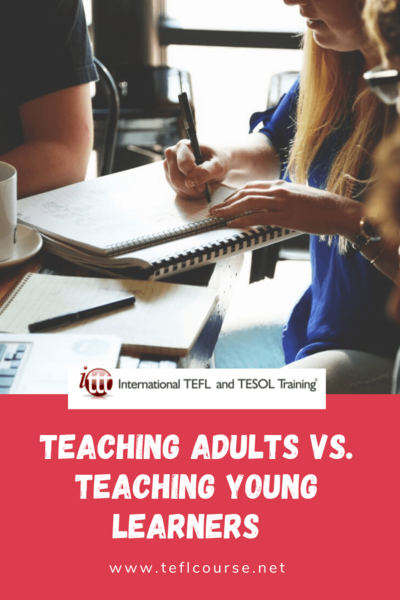Teaching Adults vs. Teaching Young Learners

Teaching can be extremely satisfying and rewarding, but how we teach and the methodologies that we use should be adapted to teaching each specific learner or groups of learners.
Table of Contents
Do you want to teach English abroad? Take a TEFL course today!
This post was written by our TEFL certification graduate Omar B. Please note that this blog post might not necessarily represent the beliefs or opinions of ITTT.
Listen to this blog post:
Types of Learners
Let's begin with defining what is considered to be an adult and what is considered to be a young learner. According to regulatory standards, an adult is an individual over the age of 18. Young learners, on the other hand, can be categorized based on three bases; from the age of seven and under (very young learners), between the ages 8 to 12 and post-puberty, usually from ages 13 to 17. How does our methodology and technique change and adapt based on the ages we teach?
When we are presented with an adult class we must take into consideration various factors that might influence the class. First of all, we must acknowledge that the students are not new to a learning environment in general. Adult students usually come with a diverse and lengthy history of learning experiences. These experiences either positive or negative ones, having gone through numerous schooling years as well as some other courses which may have had an impressionable impact on the students' perception of the class, can often be challenging to change.
This means that adult students will arrive in the classroom with many preconceptions of how the classroom and the learning process functions, which can be both beneficial and difficult for the teacher with regards to the use of new or different methods during the lesson. Young learners, on the other hand, may not have such fixed classroom concepts and can be easier to configure approaches and methods; this, however, doesn't mean that the lesson will run smoother.

Also Read: Games in The Classroom as a Fantastic Way to Start a Lesson
Motivation
When it comes to learning, motivation is key; but how do we keep our students motivated? Keeping a class motivated is essential to the learning process, having unmotivated students or teachers can be a recipe for disaster. It is important to know that what motivates one group of students might not motivate another. An appropriate example would be teaching a group of adults who will have a higher level of motivation since attendance is not mandatory but stems from some type of hygiene factor. These factors can range from any personal need to acquire the target language or some extrinsic motivation such as a job requirement.
Meanwhile, young learners usually don't decide to learn on their own which can cause a lack of motivation to learn, use and explore the language.
Also Read: Do I need a TEFL certificate to teach abroad?
Resources
The resources that are utilized throughout the course are also essential for classroom motivation. When teaching adults, we may not always be able to use the same topics as that of a class of young learners, since those topics may not be of any relevance. Adult learners require up to date topics, things that are relevant and realistic, things that can be associated with their life experience or interests. For example, teaching farm animals, even though we all love animals, adult learners might not find this topic relevant, or useful in their everyday life. The lack of relevance and connection of resources to students may cause the learners to become bored and unmotivated over time, but if we choose a topic that they like or are interested in it may captivate their attention and peak their interests.

Also Read: An Overview of Some Common Teaching Approaches
Students' Experience
When teaching adults we must also consider the fact that all adults, bring to class a bag full of life experiences, which can be very useful and can be used to the teacher's advantage. This means that the teacher can rely on these experiences to connect real-life situations to the learners' goals. The teacher can use this wealth of student experience to engage discussions, build a better rapport and share experiences with other learners. Although this seems to be very useful, we must be careful that the teacher does not make assumptions that may result in offending the student.
To conclude, teaching adults is different from teaching young learners because adults come predisposed to learning; either they need it for a specific purpose or to satisfy intrinsic goals. Teachers should take into account their interests, strengths and weaknesses, life experiences and previous knowledge, to create a successful and beneficial rapport.
Do you want to teach English abroad? Take a TEFL course today!
In my experience teaching, adults are much easier than teaching young learners since it is easier to connect with them because you have similar interests or life experiences and they are, most of the time, self-motivated. Teaching young learners is a bit more difficult but very rewarding as well. We must keep in mind that every class is different and what and how we deliver the lesson should always be encouraging but focus on the type of students.
Apply now & get certified to teach english abroad!
Speak with an ITTT advisor today to put together your personal plan for teaching English abroad!
Send us an email or call us toll-free at 1-800-490-0531 to speak with an ITTT advisor today.
Related Articles:
- The 3 Most Important Tricks When Teaching English to Kindergarteners
- Top 7 Spanish Speaking Countries for Teaching English Abroad
- Teaching ESL & Knowing Your Audience: Young Learners vs. Adults
- Top 10 Cities in Asia with the Highest Demand for English Language Teachers
- All the Documents You Will Need to Teach English Abroad
- Getting Student Placement Right - The Best Desk Arrangements for EFL Students




